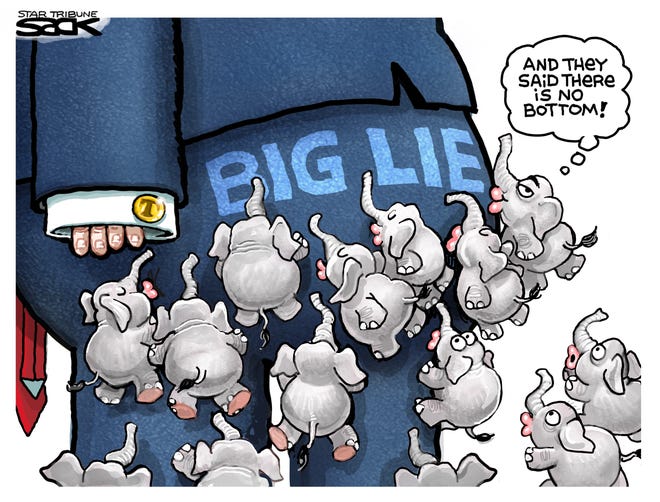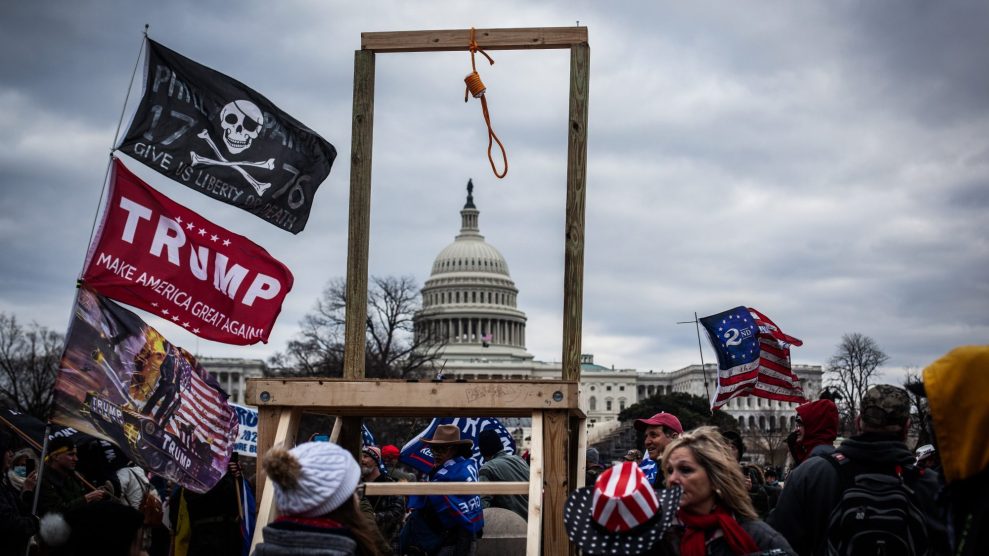Will You Storm the Capitol if the 2024 Election is Stolen?
By Thom Hartmann for the
We’re demonizing the wrong people.
This is not a call to “understand” or “have compassion” for
Trump voters. Instead, it’s a call for a wholesale political and social
indictment of Trump’s Big Lie, along with every elected Republican politician
or media member who knows Trump lost but keeps perpetuating that Lie.
If we fail, history may repeat itself and — this time — the
result will be far worse than Bush’s lying us into two wars and privatizing
Medicare.
That, in part, is because numerous Republican-controlled
states are passing laws and gaming out scenarios that could enable a repeat of
a variation on the election of 1876: if GOP-controlled swing states submit
multiple slates of electors denying either candidate 270 uniquely certified Electoral
College votes, the election could again get thrown to the House of
Representatives (as was the election of 1800, too), where
Trump (or another neofascist Republican) would win.
Democrats tend to forget that Donald Trump received about 10 million more votes in 2020 than he did
in 2016. It’s why he’s still a potent political force in America and
around the world.
Although Biden got around 7 million more votes than Trump
and overwhelmingly won the popular (and Electoral College) votes, Trump’s
raw-numbers electoral popularity actually went up at the end of the 4
years of his presidency.
Those Trump voters — from the people who stormed the Capitol on January 6th to the folks who just quietly showed up at the polls and never mentioned anything political to neighbors, friends or relatives — believed he was the best guy for the presidency.
And today, about three-quarters of them (76%) also now believe
that his presidency was stolen from him in 2020.
Consider, for a moment, if the tables were reversed:
It’s 2024 and President Biden and Donald Trump just faced off
in the election. Biden wins the popular vote by over 10 million, but the
Electoral College vote is up in the air because of a weird constitutional
technicality.
Just like in the election of 1876, several swing states in
the midst of political turmoil have submitted dueling slates of electors, one
(based on the popular vote) for Biden and another (reflecting the will of the
state legislature) for Trump. And, just like in 1876, when you exclude
the “contested states” neither candidate hits the 50%-plus-one electoral votes
needed (now 270) to win the White House.
Under the 12th Amendment, as John Eastman pointed out in his 2020 memo
to Trump (and echoed by Jenna Ellis and Mark Meadows), that throws the election
to the House of Representatives, where each state has one single vote, that
vote being decided by each state’s legislature back home. Thirty states are Republican controlled
and submit their 30 votes for Trump, with Biden receiving the remaining 20: the
House declares the election goes to Trump.
Democrats immediately sue before the Supreme Court, but —
for the second time in history — the Court awards the presidency to the
Republican who lost the popular vote amid a contested Electoral College vote.
Trump, say the Republicans in Congress and on the Court, is
to be sworn in as president a few weeks after the votes are certified on
January 6th, 2024.
But President Biden calls a press conference to tell the
nation that the states that submitted dual ballots were behaving with corrupt
intent just to allow this very scenario to play out.
“Trump and his Republican allies used a technicality in our
Constitution and law to claim they won an election they very clearly lost,”
Biden says. “Americans shouldn’t stand for this!”
All across the country, people begin pouring into the
streets. Pitched battles break out between Trump and Biden supporters, as
cities are set afire and hundreds die from gunshots.
What do you do?
This would be, after all, the fourth time Republicans have
tried to use this same strategy to bring a presidential election around to
themselves on their own terms, and the first two out of three times they were
successful.
How Republicans Pulled It Off In 1876
The first was the election of 1876, when the Republican who lost that election (both popular and Electoral College), Rutherford B. Hayes, was nonetheless installed as president by the House of Representatives in March, 1877.
Democrat Samuel Tilden won the popular vote nationwide but,
with 184 electoral votes, was one vote short of the then-necessary 185
electoral votes to become president.
Republican Rutherford B. Hayes not only lost the popular
vote but had only 163 uncontested electoral votes. (He was sold to voters as an
antidote to the Radical Republicans like Thaddeus Stevens
who’d worked so hard to bring formerly enslaved people into politics. White
supremacists were rising again…in both parties.)
Ohio’s Republican Congressman James Monroe (not related to the president of generations earlier of the same name) wrote the definitive summary of that election and how it played out in Congress, a narrative he published in the Atlantic in October 1893.
Pointing out that “the votes of Florida, Louisiana, Oregon,
and South Carolina, with an aggregate of 22 electors” would turn the election
to either Hayes or Tilden, Monroe (who was there) wrote, “From the States just
named there were two sets of returns, one favorable to General Hayes, the other
to Mr. Tilden.”
The dispute had to do with three of those four states then
being occupied by the Union Army (this was just 11 years after the Civil War
ended, and Reconstruction was in full swing). At the same time, the Klan was
riding high in all four states and ran much of Oregon’s politics as a “utopian all-white frontier.”
Formerly enslaved African Americans were trying to turn out large numbers of voters for the Republican candidate, but there was also widespread Klan activity suppressing that Black vote.
On the other side,
Democrats in Congress charged that Union soldiers had intimidated Southern
Democratic voters, suppressing their vote.
Monroe wrote the Democrats charged “that these returns [in those
four states for Republican Hayes] were a product of fraud and dishonesty; that,
in preparing them, the vote of whole precincts, parishes, and counties had been
thrown out in order to secure Hayes electors… [and] they did not represent the
people of those States, but were themselves the product of fraud and
corruption, and were kept in place only by what was called the ‘moral
influence’ of Federal bayonets.”
The nation nearly exploded, wrote Monroe:
“The feeling of mutual hostility had been greatly intensified
by party leaders, orators, and presses. In some of our cities it took all the
terrors of the police court to keep Democrats and Republicans from breaking the
peace.”
The 12th Amendment, ratified in 1804, had a simple solution
to the problem of neither candidate winning a majority of electoral votes.
“[I]f no person have such majority,” the 12th Amendment says, “then… the House
of Representatives shall choose immediately, by ballot, the President. But in
choosing the President, the votes shall be taken by states, the representation
from each state having one vote…”
Because all the Southern states had now been re-admitted to
the Union, a majority of the House of Representatives that year were controlled
by Democrats, as were a majority of the states. With each state’s delegation
having only one vote, the Democratic-controlled House representing a Democratic
majority of states would end up making Democrat Tilden the president, something
the Republicans wouldn’t go along with.
Republicans added that because the 12th Amendment also says
that “The President of the Senate shall, in the presence of the Senate and
House of Representatives, open all the certificates and the [electoral] votes
shall then be counted…” that the president of the Senate should be the one to
make the call as to which state’s contested votes were legitimate.
The Constitution provides that the vice president shall be
the president of the Senate, but President Ulysses Grant’s veep, Henry Wilson,
had died the previous year and Grant hadn’t replaced him; the president of the
Senate in 1876 was Senator Thomas Ferry of Michigan, a Republican.
“[I]t would have been as unsatisfactory to Republicans to
have the vote declared by the House,” wrote Monroe, “as it would have been to
Democrats to have it declared by the President of the Senate.”
“The situation was serious,” Monroe wrote. “Some thoughtful
men felt that perhaps the greatest peril that the Republic had encountered was
not that of the Civil War” but that “within a hundred days, people would be
cutting each other’s throats.”
Of Senator Banning of Ohio, “My colleague,” Monroe wrote,
“declared in a speech, that, if the Republicans should attempt to carry out
their theory of the election, and if a part of the army with eighty rounds of
ammunition, and the navy, should be ordered to support them, then the people
would put them all down.”
In response, Virginia’s Congressman Goode stood up and
loudly asked his colleagues if they were willing to restart the Civil War.
“A shout of ‘Yes’ went up from the Republican side of the
House,” wrote Monroe.
Cooler heads ultimately prevailed, and both sides worked out
a compromise that gave the GOP the White House but only on the condition that
the newly minted President Hayes would remove Union troops from the Southern
states, ending Reconstruction.
The republic was saved and the Republicans took the White
House, but only by selling out Southern Black people for the next hundred
years.
How Republicans Pulled It Off in 2000
In the 2000 election, Texas Governor George W. Bush and his brother, Florida Governor Jeb Bush, appear to have worked together to rig the Florida outcome.
Because it all came out after Bush was already sworn in
a month earlier, the American media largely ignored the story when the BBC broke
it on February 16, 2001.
Greg Palast did the report for the BBC, which has a transcript on their website. They
note:
“Did Governor Jeb Bush, his Secretary of State Katherine
Harris, and her Director of Elections, Clayton Roberts, know they had wrongly
barred 22,000 Black, Democrat voters before the elections? After the elections
did they use their powers to prevent the count of 20,000 votes for the
Democrats? The Democrats say the answers to both questions are yes.”
Jeb Bush, Palast found, had paid an outside vendor $4
million to take a felon list supplied by Texas and compare its names against
the entire Florida voter database, using loose matches that didn’t always
involve middle names or dates of birth.
As a result, at least 22,000 Florida voters, most Black men
with similar names to Black felons in Texas, were purged from the voting rolls
just before the election. (His report for the BBC is at the bottom of this
article.)
While the American public was largely unaware of this aspect
of the 2000 election, the Florida Supreme Court approved an appeal from Florida
Democrats and ordered a recount of that state’s vote.
Roger Stone claims he helped organize the
so-called “Brooks Brothers Riot” (see below) in which staffers for multiple Republican
lawmakers went to Florida and, along with local GOP activists, demanded that
the State Supreme Court-ordered recount be stopped. It got nationwide
news coverage, although it was presented merely as average Floridians
expressing outrage.
Piggybacking on the apparent GOP outrage in Florida, five Republican appointees on the US Supreme Court stopped that then-already-ongoing recount of the Florida vote, something that had never before happened in US history.
In the Bush v. Gore Supreme Court
decision in 2000 that stopped the Florida recount — and thus handed George W.
Bush the presidency — Justice Antonin Scalia wrote in his opinion:
“The counting of votes … does in my view threaten irreparable
harm to petitioner [George W. Bush], and to the country, by casting a cloud
upon what he [Bush] claims to be the legitimacy of his election.”
Apparently, denying the presidency to Al Gore, the guy who
actually won the most votes in Florida and won the popular vote nationwide by
over a half-million, did not constitute “irreparable harm” to Scalia or the
media.
And apparently it wasn’t important that Scalia’s son worked for a law firm that was
defending George W. Bush before the high court (with no Scalia
recusal).
Just like it wasn’t important to mention that Justice Clarence Thomas’s wife worked on the
Bush transition team — before the Supreme Court shut down the
recount in Florida — and was busy accepting resumes from people who would serve
in the Bush White House if her husband stopped the recount in Florida…which he
did. (No Thomas recusal, either.)
More than a year after the election a consortium of
newspapers including The Washington Post, The New York Times, and USA Today did
their own recount of the vote in Florida — manually counting every vote in a
process that took almost a year — and concluded that Al Gore did indeed win the
presidency in 2000.
As the November 12th, 2001 article in The
New York Times read:
“If all the ballots had been reviewed under any of seven
single standards and combined with the results of an examination of overvotes,
Mr. Gore would have won.”
That little bit of info was slipped into the seventeenth
paragraph of the Times story so that it would attract as little attention as
possible because the 9/11 attacks had happened just weeks earlier and
journalists feared that burdening Americans with the plain truth that George W.
Bush actually lost the election would further hurt a nation already in crisis.
How Republicans Tried To Pull It Off a Third Time in 2020
The third time wasn’t the charm.
Roger Stone and his friends pulled together another “stop
the steal” event on January 6th to prevent the certification of Joe Biden as
president, using the same sort of rhetoric about “sore loser Democrats” that
had worked so well for them in Florida 20 years earlier.
Blowing up his scheme, the Supreme Court refused to
intervene this time and the election went to Biden. But Trump continued —
as President of the United States — to insist the election had been stolen from
him.
In 2000 the mainstream American media had largely turned
against Al Gore, as the five rightwingers on the Supreme Court had given an
aura of legitimacy to Bush’s selection as president.
In 2020, by contrast, the Court said “No,” so mainstream
media clearly saw and reported that Biden had won the election.
Multiple rightwing media outlets, however, including 1,500
rightwing English-language radio stations, several hundred Spanish-language
rightwing radio stations, and three rightwing television networks, picked up
Trump’s claim of a stolen election and echoed and amplified it as if it were
true. Facebook’s algorithm pushed Trump’s false claim into millions more
American homes.
The result was the most massive polarization of the American
electorate since the Civil War, and an open and armed assault on the US
Capitol.
Which brings us back to 2024.
If the media chooses their 2020 course, Biden may
prevail.
If they follow their 2000 script, though, ignoring election
irregularities and outright fraud that benefits Republicans, Trump will
probably be installed in the White House.
And the Supreme Court may again play an illegitimate role in
it all.
So, what will Democrats do? Will we be in the
streets? Will protest even be possible?
Will second-term President Trump succeed in mobilizing the
military — as he unsuccessfully tried to do in 2020 — to violently put down
protests like tinhorn dictators do, and again begin snatching people off the
streets in unmarked vans like he did in Portland last year?
And, thinking of the scenario in these terms, consider what
it teaches us about how we should deal with the “stolen election” dynamic Trump
is now promoting.
It depends in large part on Republicans continuing to
believe Trump’s Big Lie that the 2020 election was stolen from him.
The best way to stop this nightmare before it happens is for
both elected Democrats (and the few semi-sane Republicans left, like Cheney and
Christie) and the nation’s media to not only call out Trump’s lie, but also
call out the media that keeps it alive.
And fixing our broken Electoral College by revising the 1877
Electoral Count Act that followed the election of 1876 couldn’t hurt
(taking the Electoral College out of the Constitution altogether, the best
solution, is an unrealistically big lift for today).
Otherwise, we may well be facing that terrible question that
Trump true believers faced last year: what do we do?
It’s time to stop this before it goes any farther.
Winter is coming...
Thom Hartmann is a talk-show host and the author of The Hidden History of American Healthcare and more than 30+ other books in print. He is a writing fellow at the Independent Media Institute and his writings are archived at hartmannreport.com.




